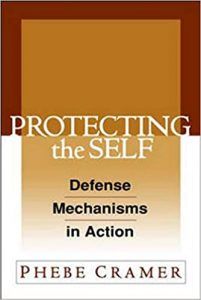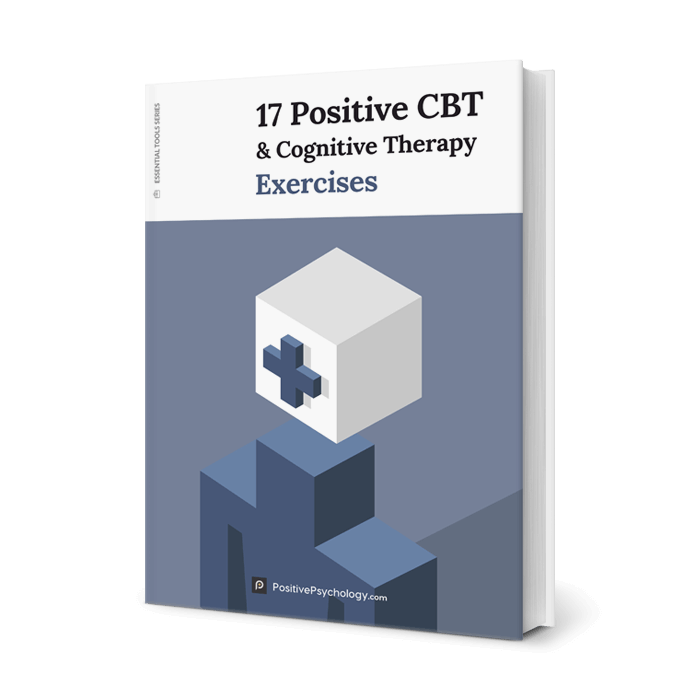Defense Mechanisms Worksheets: 10 Tools for Practitioners
 Perhaps unsurprisingly, we are all likely to experience trauma more than once in our lives.
Perhaps unsurprisingly, we are all likely to experience trauma more than once in our lives.
Less widely known is our reliance on psychological defenses to manage our responses to such life events and reduce anxiety (Fang, Chung, & Wang, 2020).
Such automatic and typically unconscious processes act as defense mechanisms, protecting and defending us from further distress while reducing our awareness of internal danger.
Primitive and less effective defense mechanisms are often adopted by those who fail to learn better ways of coping with stressful events (Metzger, 2014).
This article introduces the concept of defense mechanisms and several tools practitioners use to uncover and examine them during therapy.
Before you continue, we thought you might like to download our three Positive CBT Exercises for free. These science-based exercises will provide you with detailed insight into positive Cognitive-Behavioral Therapy (CBT) and give you the tools to apply it in your therapy or coaching.
This Article Contains:
Uncovering Defense Mechanisms: 4 Questionnaires & Tests
Our psychological defenses are vital in explaining how we differ in our reactions to trauma and stress (Fang et al., 2020).
Psychology defines such mental processes as “mechanisms that mediate the individual’s reaction to emotional conflicts and to external stressors” (American Psychiatric Association, 2013, p. 819).
Defense mechanisms are typically “ordered hierarchically and divided into four categories according to their psychosocial maturity and level of adaptedness” (Fang et al., 2020, p. 2), as follows:
- Psychotic defenses
Mechanisms in place to avoid conflicts experienced in relating to the external world, such as the denial and distortion of what has happened - Immature defenses
Psychological processes that reduce anxiety and distress caused by threatening individuals and reality, such as projection, acting out, and passive aggression - Neurotic defenses
Psychological defenses that intend to keep associated feelings, fears, and ideas outside of awareness, such as repression, displacement, and isolation - Mature defenses
Mental processes that are successful in increasing our sense of gratification while allowing a conscious awareness of related feelings and ideas, such as humor and altruism
Ultimately, immature psychological defense mechanisms are likely to become associated with psychiatric illness. As such, the development of psychological problems can be managed and moderated by the defense mechanisms used by the individual (Fang et al., 2020).
Therefore, it is valuable for mental health professionals and clients to become more aware of which defense mechanisms mediate the client’s reaction to emotional conflicts and external stressors (Boldrini, Lo Buglio, Giovanardi, Lingiardi, & Salcuni, 2020; Lengfelder, n.d.).
Researchers have developed a series of tests to identify and score defense mechanisms; we describe some of the more popular and well-validated ones below.
Defense Mechanism Rating Scale
The Defense Mechanism Rating Scale (DMRS) is a psychological assessment used to review transcripts of clinical interviews and therapy sessions and assess the use of defense mechanisms.
Each one (from a list of 30) is rated as no use, probable use, or definite use according to a set of definitions, descriptions, and distinguishing rules (Boldrini et al., 2020).
Three further ratings include:
- Overall defensive functioning – the frequency of each defense mechanism combined with an associated weighting
- Defense level scores – a percentage based on seven defense levels
- Individual defense scores – proportional scores that enable the ordering of the defense mechanisms
Based on the assessment, each defense mechanism is assigned to one of the following seven defense levels, from the least to the most adaptive, as follows:
- Action defenses
Used to act or withdraw to deal with stressors (including acting out, passive aggression, etc.) - Major image distortion defenses
Used to eliminate ambivalence by forming a single emotional view (including the splitting of self-image and others’ images) - Disavowal defenses
Used to avoid the reality of stressful events (including denial and projection) - Minor image distortion defenses
Used to dismiss problems by distorting the image of self (including omnipotence or devaluation of self and others) - Neurotic defenses
Used to maintain a lack of awareness regarding conflicting needs and desires (including repression, disassociation, etc.) - Obsessional defenses
Used to distance the individual from threatening feelings while maintaining cognitive awareness without distortion (including undoing, intellectualization, etc.) - High adaptive defenses
Demonstrating the highest (most mature) adaptation to life while integrating feelings, ideas, and consequences (including affiliation, humor, and altruism)
The DMRS can help identify patients at risk of psychosis and is a valuable tool for therapy (Boldrini et al., 2020).
Psychotic-Defense Mechanism Rating Scales (P-DMRS)

- Psychotic denial
- Autistic withdrawal
- Distortion
- Delusional projection
- Fragmentation
- Concretization
The P-DMRS provides another helpful tool for health professionals to identify patients at risk of psychosis (Boldrini et al., 2020).
Defense Style Questionnaire
The Defense Style Questionnaire (DSG-40) is a research-based assessment tool helpful in identifying the hierarchy of defense mechanisms used by an individual in dealing and coping with conflict (Fang et al., 2020; Giovazolias, Karagiannopoulou, & Mitsopoulou, 2017).
The 40-item questionnaire measures three types of defense styles (immature, neurotic, and mature) on a nine-point Likert scale between 1 (strongly disagree) and 9 (strongly agree).
Sample statements include (Fang et al., 2020):
- Immature style – I often act impulsively when something is bothering me.
- Neurotic style – If someone mugged me and stole my money, I’d rather the person be helped than punished.
- Mature style – I work out my anxiety through doing something constructive and creative like painting or woodwork.
The DSG-40 is widely used in research and therapy and is shown to be valid and helpful across various clinical groups. It has proven successful in identifying individuals at risk of bullying and victimization and is particularly helpful in younger populations (Giovazolias et al., 2017).
Life Style Index
The Life Style Index (LSI) is a self-administered questionnaire created to assess eight defense mechanisms. It has been widely used, having been translated into many languages (Hyphantis et al., 2011).
Created by Plutchik, Kellerman, and Conte (1979), the LSI is a 97-item, self-report questionnaire that assesses eight ego defense mechanisms:
- Compensation
- Denial
- Displacement
- Intellectualization
- Projection
- Reaction formation
- Regression
- Repression
Examples of statements used for assessment include:
I am a very easy person to get along with.
When I want something, I just can’t wait to get it.
People do not consider me to be an emotional person.
The scale has identified positive links between the type of psychological defense mechanism adopted by individuals and their risk of anxiety, suicidal thoughts, stress, and physiological health status, including cancer and inflammatory bowel disease (Hyphantis et al., 2011).
6 Valuable Worksheets for Your Clients
Identifying and understanding defense mechanisms is essential during the process of psychotherapy.
After all, “not recognizing reality can result in self-injurious behavior” (Cramer, 2015, p. 523).
However, it is important to note that psychological defense mechanisms are an essential element of the human mind, offering protection from psychological upset. As with coping mechanisms, they are part of normal psychological functioning (Cramer, 2015).
Repeated reliance on immature defense mechanisms, however, can be harmful to psychological wellbeing.
The following worksheets focus attention on the recognition and replacement of defense mechanisms adopted by the client and promote self-reflection.
Understanding Your Problem-Solving Approach
Over time, the way we approach and resolve problems becomes habitual and part of our usual way of thinking.
It can be helpful to reflect on how we tackle problems and obstacles and the psychological mechanisms we employ.
Think of an event that has happened or one that you are expecting in the future and use the Understanding Your Problem-Solving Approach worksheet to answer the following questions:
- What is the situation?
- What were your thoughts (or what are they likely to be)?
- How did you feel (or how do you expect to feel)?
- How did (or will) you react? What behavior did (or will) you show?
- What was (or do you expect to be) the outcome?
Becoming more aware of how you typically react can help you stop, think, and consider if your approach is working or whether it is time to try something new.
What’s the Truth?
People damaging our psychological wellbeing inflict harm by what they say.
While usually false, such statements can cause us to draw upon, sometimes unhelpful, psychological defense mechanisms.
Reflecting on what was said and comparing it with the truth or what we believe to be true can be a positive handling technique.
Use the What’s the Truth? worksheet and capture what was said versus what you know to be true.
Reflect on the ‘truths’ and use them to challenge or replace what was said during or after conversations.
What Should I Say?
Our automatic thoughts and responses can be unhelpful, harming how we react to situations and our cognitive, emotional, and behavioral responses.
Use the What Should I Say? worksheet to rewrite negative thoughts using more positive wording.
In the future, try to replace each negative thought with a more positive one to build a helpful and positive mindset and a growth outlook.
For example:
‘I am useless at doing this’ becomes ‘I am new to this, but with help and hard work, I will soon learn.’
‘No one likes me’ becomes ‘These people don’t know me yet, but I have plenty of other friends.’
Do you know your 12 defense mechanisms? – Kati Morton
What Behavior Do I Want to Change?
Problematic behavior can arise from unhelpful thinking habits, but that does not mean we have to continue with it into the future.
Through reflecting on what has happened, our thinking, and our behavior, we can consider new responses and learn to react in a more positive, helpful way.
Use the questions in the What Behavior Do I Want to Change? worksheet to identify what behavior must be addressed and how this could be achieved, including:
- What is the behavior? (such as, arguing or yelling)
- What can I do to start preparing to change? (such as focusing on relaxation, taking time out when needed)
- What steps should I take to make this happen? (such as enrolling in a mindfulness class or taking some online training)
- What can other people do to help me change my behavior? (such as supporting you and remaining patient after you explain the changes you want to make)
Changing how we think and react can take time, effort, and patience, yet the rewards make it worthwhile.
Tracking My Anger
Immature or unhelpful psychological responses often lead to us lashing out and responding angrily.
Typically, this is hurtful to ourselves and others and damaging to our relationships.
Identifying patterns in our reactions and behavior can help us recognize opportunities to improve.
Use the seven-day tracker in the Tracking My Anger sheet to monitor your anger or any other unwanted reactions over the course of a week.
At the end of the week, review the tracker and consider the triggers and your response.
Ask yourself, what patterns form? Were my responses justified? How else could I handle these situations in the future?
Recognizing How We Think, Feel, and Behave
Our mental and physical responses overlap and impact how we think, feel, and behave.
Creating a physical picture of how we respond – cognitively, emotionally, and physically – can help us understand why we behave as we do.
Identifying patterns in our reactions and behavior can help us recognize opportunities to change unhelpful beliefs, thoughts, and automatic psychological processes.
Download the Recognizing How We Think, Feel, and Behave worksheet. Print out the diagram and think of a difficult situation that you have faced recently.
Scribble or draw pictures beside each label to capture the impact of the event on each element.
Ask yourself, what can I learn from my thoughts, behavior, physical sensations, and emotions? Were they justified, rational, or appropriate?
If not, what could I change in the future?
Best Books on the Topic
Several books review the history and the most recent research and findings in psychological defense mechanisms. We have included three of our favorites.
1. Protecting the Self: Defense Mechanisms in Action – Phebe Cramer
This valuable book provides a comprehensive insight into psychological defense mechanisms and their role in human development and psychopathology.
Phebe Cramer provides a detailed examination of the defenses we adopt and engage in as we develop to maintain psychological equilibrium.
Find the book on Amazon.
2. Why Do I Do That? Psychological Defense Mechanisms and the Hidden Ways They Shape Our Lives – Joseph Burgo
Taking strategies from psychotherapy, Joseph Burgo guides the reader on a voyage of self-exploration to understand the role of psychological defenses in excluding difficult emotions from our awareness.
Burgo concludes with a description of how we can disarm our defenses and manage our feelings more successfully.
Find the book on Amazon.
3. Vital Lies, Simple Truths: The Psychology of Self-Deception – Daniel Goleman
A lighter read, this book is a valuable and fascinating exploration of how we deceive ourselves, from renowned writer Daniel Goleman.
Goleman explains why self-deception is a basic and typically benign human trait, yet it can be damaging and must be kept in check to avoid limiting what we experience and achieve.
Find the book on Amazon.
PositivePsychology.com’s Helpful Tools
We have many tools to help your clients adopt more healthy, helpful, and successful coping strategies and move away from harmful thinking styles and approaches.
To help, check out the following free worksheets and handouts.
- Coping Styles Formulation
This CBT coping styles worksheet is based on case conceptualization and can help therapists and clients come to a shared understanding of a presenting problem and develop more adaptive coping strategies. - Explore Coping Modes
This worksheet can help clients systematically track the origin, triggers, and consequences of positive and negative coping strategies. - TRAPS to Avoid and TIPS for Success
This handout puts forward a range of suggestions to facilitate better conflict resolution in families or with kids. - Challenging Catastrophic Thinking
This worksheet invites clients to select an upcoming event they are worried about, explore catastrophic thinking surrounding that event, and realistically evaluate different outcomes and coping resources at their disposal. - Thought Record Worksheet
This worksheet helps clients systematically recognize and review dysfunctional thinking triggered in response to particular situations or events.
17 Positive CBT Exercises
If you’re looking for more science-based ways to help others through CBT, this collection contains 17 validated positive CBT tools for practitioners. Use them to help others overcome unhelpful thoughts and feelings and develop more positive behaviors.
A Take-Home Message
Immature psychological defense mechanisms are associated with mental health issues. At the same time, more mature processing of positive and negative events can benefit psychological wellbeing (Cramer, 2015).
Therapists and clients need to understand the defense strategies being employed, especially those that are ongoing and used to handle troublesome life events.
Using verified questionnaires can provide a more complete picture of psychological wellness and valuable insight into interventions that promote a healthy outlook and an increased awareness of (typically) unconscious, automatic thinking.
Choosing mature defense mechanisms will help the client tackle life head on while being engaged and present in the negatives and the positives they face. Strategies such as humor protect us from stress and anxiety while promoting positive mental health, resilience, and greater engagement.
Try out some of the questionnaires and worksheets, and use them for client psychoeducation to increase their awareness of the strategies they adopt and give them the power of choice and control over how they respond to life events.
We hope you enjoyed reading this article. Don’t forget to download our three Positive CBT Exercises for free.
- American Psychiatric Association. (2013). Diagnostic and statistical manual of mental disorders (5th ed.). Author.
- Boldrini, T., Lo Buglio, G., Giovanardi, G., Lingiardi, V., & Salcuni, S. (2020). Defense mechanisms in adolescents at high risk of developing psychosis: An empirical investigation. Research in Psychotherapy: Psychopathology, Process and Outcome, 23(1).
- Burgo, J. (2012). Why do I do that? Psychological defense mechanisms and the hidden ways they shape our lives. New Rise Press.
- Cramer, P. (2006). Protecting the self: Defense mechanisms in action. Guilford Press.
- Cramer, P. (2015). Understanding defense mechanisms. Psychodynamic Psychiatry, 43(4), 523–552.
- Fang, S., Chung, M. C., & Wang, Y. (2020). The impact of past trauma on psychological distress: The roles of defense mechanisms and alexithymia. Frontiers in Psychology, 11.
- Giovazolias, T., Karagiannopoulou, E., & Mitsopoulou, E. (2017). Can the factor structure of Defense Style Questionnaire (DSQ-40) contribute to our understanding of parental acceptance/rejection, bullying, victimization and perceived well-being in Greek early adolescents? Europe’s Journal of Psychology, 13(2), 269–285.
- Goleman, D. (1996). Vital lies, simple truths: The psychology of self-deception. Simon & Schuster.
- Hyphantis, T., Goulia, P., Floros, G. D., Iconomou, G., Pappas, A. I., Karaivazoglou, K., & Assimakopoulos, K. (2011). Assessing ego defense mechanisms by questionnaire: Psychometric properties and psychopathological correlates of the Greek version of the Plutchik’s Life Style Index. Journal of Personality Assessment, 93(6), 605–617.
- Lengfelder, B. (n.d.). Clinical education and interventions for defense structures of co-occurring populations. Retrieved August 4, 2021, from https://www.naadac.org/assets/2416/brian_lengfelder_ac17ppt.pdf
- Metzger, J. A. (2014). Adaptive defense mechanisms: Function and transcendence. Journal of Clinical Psychology, 70(5), 478–488.
- Plutchik, R., Kellerman, H., & Conte, H. R. (1979). A structural theory of ego defenses and emotions. In C. E. Izard (Ed.), Emotions in personality and psychopathology (pp. 229–256). Plenum.
Read other articles by their category
- Body & Brain (50)
- Coaching & Application (57)
- Compassion (26)
- Counseling (51)
- Emotional Intelligence (24)
- Gratitude (18)
- Grief & Bereavement (21)
- Happiness & SWB (40)
- Meaning & Values (26)
- Meditation (20)
- Mindfulness (45)
- Motivation & Goals (45)
- Optimism & Mindset (34)
- Positive CBT (29)
- Positive Communication (20)
- Positive Education (47)
- Positive Emotions (33)
- Positive Leadership (18)
- Positive Parenting (4)
- Positive Psychology (33)
- Positive Workplace (37)
- Productivity (17)
- Relationships (46)
- Resilience & Coping (38)
- Self Awareness (21)
- Self Esteem (38)
- Strengths & Virtues (32)
- Stress & Burnout Prevention (34)
- Theory & Books (46)
- Therapy Exercises (37)
- Types of Therapy (64)








